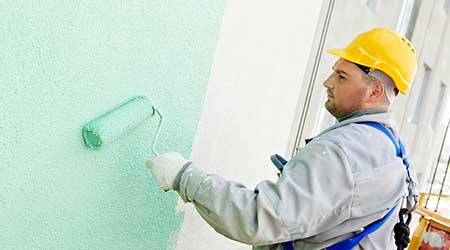Specifying Paints and Coatings For Facility Needs
Specifying to meet facility sustainability needs means staying abreast of changes in products and applications
To help maintenance managers match the ever-expanding array of paints and coatings with their facilities’ needs, manufacturers have developed selector charts. One manufacturer’s chart contains 25 paints listed by product name, code, and type, as well as information on how well they meet the requirements of 28 properties and 10 substrates.
Scanning the chart shows that many products fit multiple needs. Looking for these versatile products is a proven strategy managers can use to minimize paint inventory.
Managers can choose from among several paints of the same type — for example, acrylic — but that differ in price. How can managers choose the most appropriate?
Pigment is the main factor in cost. The higher the pigment percent in a formulation, the better the quality and longer-lasting and more durable the paint will be, but its initial cost might be higher. Considering the life factor, the higher first cost might be the lowest overall cost choice.
One important matching consideration is the environment where workers will apply the paint. Consider the example of educational institutions. Some formulations for applications in schools are created to address specific issues:
- high-traffic areas, such as halls, lockers, gyms, and cafeterias
- zero- or low-VOC and low odor for high-density spaces, including classrooms and dorms
- fast turnarounds, as in classrooms and offices
- exterior areas subject to environmental elements, such as entrances, athletic fields, fences, and stands.
Acrylic formulations, which are available in paints suitable for interior and exterior uses and come in gloss, semi-gloss, matte, and flat finishes, can meet these demands.
Recent advances, including an explosion of new color choices, also address managers’ challenges related to color matching.
A color-matching app can scan the paint or fabric or furniture color that requires matching and offers the tint type and quantity that matches. Other apps enable virtual painting of several rooms to see results before purchasing a product.
Specifiers also can send a picture of the color to a paint supplier color consultant, who offers guidance on products that will match. Light sensors indicate when lighting on a sample is the same as on the matching product. Morning sunlight is bright and is used by many industries to verify a good color match.
Managers also should revisit their tinting practices in an effort to improve color matching. For example, by buying larger containers of white and tinting the amount needed for a project, managers can get a quantity discount, meet the need for different colors at the same time, and avoid having too many containers of leftover, differently colored paints.
Another approach that some have found success with is to start with a darker shade and add white until the result is a match. Matching both the amount of pigment and the amount of gloss is necessary to achieve effective results.
One additional important step in the matching process is obtaining the material safety data sheet (MSDS) for each product and have it available at the point of container storage and readily accessible by workers.
Some data points on the MSDS are: hazards; first aid measures; firefighting; accidental release remedies; handling and storage; exposure control and personal protection; stability and reactivity; toxicology information; ecological, disposal, and regulatory information; physical data, such as weight, VOC, and flash point; and U.S. Department of Transportation shipping classification information.
Managers also face an expanding set of challenges specifying coatings. Acrylic coatings that meet ASTM D6083 can be applied to co-polymer alloy, EPDM, Hypalon, metal, polymer foam, PVC, Neoprene, and TPO roofing. Polyurethane coatings can be applied to all eight of these substrates, as well as asphalt built-up and modified bitumen roofs.
Additional coatings options are silicone, polyurea and aluminum. Installers can apply silicone over concrete, single-ply roofing, metal, and spray-in-place urethane foam. Polyurea coatings are specified for polyurethane roofs, and some formulations have the Energy Star rating for color and reflectivity.
Aluminum coatings are formulated to protect and waterproof: previously white- or aluminum-coated roofs; asphalt built-up roofs; EPDM; and steel, galvanized and tin metal roofs. Water-based coatings tend to dissolve when flooded with rain more so than the solvent-based coatings.
Thomas A. Westerkamp is a maintenance and engineering management consultant and president of the work management division of Westerkamp Group LLC.
Related Topics:














